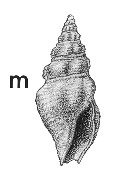
Revised descriptions of New Zealand Cenozoic Mollusca from Beu and Maxwell (1990)

 | Revised descriptions of New Zealand Cenozoic Mollusca from Beu and Maxwell (1990) | 
|
  (Pl. 8m): GS9508, J40/f8803, McCulloch's Bridge, Kaiatan (GNS) |
Beu & Maxwell (1990): Chapter 8; p. 126; pl. 8 m.
Synonymy: Clathurella rudis Hutton 1885b, p. 328; Mangilia (Clathurella) rudis; Borsonia rudis; Cordieria haasti Finlay 1930b, p. 83; C. verrucosa Finlay 1930b, p. 83-84
Classification: Turridae: Mitromorphinae
Description: Size moderate for subfamily (height 10-17 mm), ovate, spire highly variable, 0.4-0.7 total height. Protoconch mamillate, of about 1.5 smooth whorls. Teleoconch of 5- 6 whorls, weakly shouldered at or somewhat above middle on spire; sutural ramp slightly concave, with a low subsutural fold; last whorl shallowly excavated, with a short, in many specimens ill-defined, neck. Axial sculpture of prominent rounded costae with concave interspaces, subobsolete on ramp and usually weakening before reaching lower suture, dying out on upper part of base of last whorl, and in many shells becoming obsolete on last half-whorl; 7-11 costae on penultimate whorl. Spiral sculpture highly variable, in some shells consisting of a few narrow, rather subdued cords on sides of spire whorls, joined by somewhat finer cords on base and neck, in other shells restricted to subobsolete peripheral threads. Aperture elongate-pyriform, with a rather poorly defined, short, unnotched siphonal canal. Columella gently convex with 2 narrow plaits, one somewhat above middle, other (usually slightly stronger) near adapical end. Inner lip thinly glazed, flush; outer lip thin, weakly Urate well within aperture on some shells, with a shallow, arcuate anal sinus just below suture.
Comparison: This little turrid is one of the most abundant molluscs at McCulloch's Bridge and is also one of the most variable. Finlay (1930b, pp. 83-84) segregated Cordieria haasti and C. verrucosa on the basis of alleged differences in shape, coarseness of spiral sculpture and number of axial costae per whorl, but study of large samples shows that these differences are not constant and that the various morphotypes grade into one another (Maxwell 1992, pp. 160-161). Finlay (1930b, p . 84) also recognised another species of Cordieria, C. huttoni, from McCulloch's Bridge; this does seem to be a distinct taxon differing from C. rudis in its smaller size (maximum height 11 mm), more slender shell, less prominent and less nodular axial sculpture, more prominent spiral sculpture and weaker columellar plaits.
Cordieria occurs widely in the European Cenozoic and is also recorded from the Eocene of North America and Australia (Powell 1966, p. 59, 60; Long 1981, p. 32- 34). A Recent species occurs at depths of 140-190 m in the Caribbean (Powell 1966, p. 59). Apart from the two McCulloch's Bridge species, New Zealand records of the genus are from the upper Waihao River (Mangaorapan ?) and Trig M, Totara (Runangan).
Distribution: Kaiatan; "Waiho" [sic] (type locality of C. rudis — probably McCulloch's Bridge); Waihao Greensand, McCulloch's Bridge (type locality of C. haasti and C. verrucosa) (very common); Kapua Tuff, Waihao River (moderately common).
Cite this publication as: "A.G. Beu and J.I. Raine (2009). Revised
descriptions of New Zealand Cenozoic Mollusca from Beu and Maxwell (1990). GNS
Science miscellaneous series no. 27."
© GNS Science, 2009
ISBN
978-0-478-19705-1
ISSN 1177-2441
(Included with a PDF facsimile file
copy of New Zealand Geological Survey Paleontological Bulletin 58 in CD version
from: Publications Officer, GNS Science, P.O. Box 30368 Lower Hutt, New
Zealand)